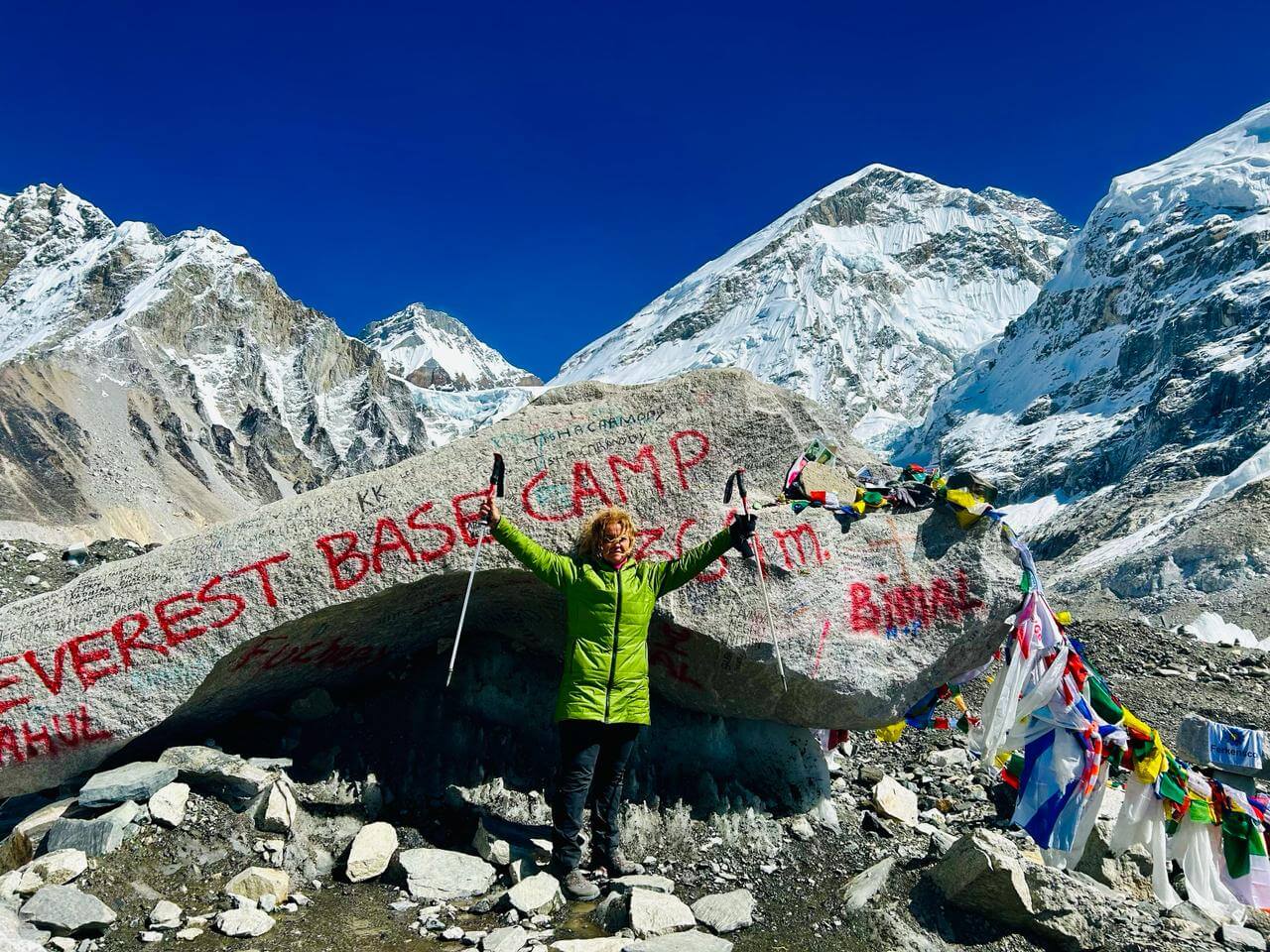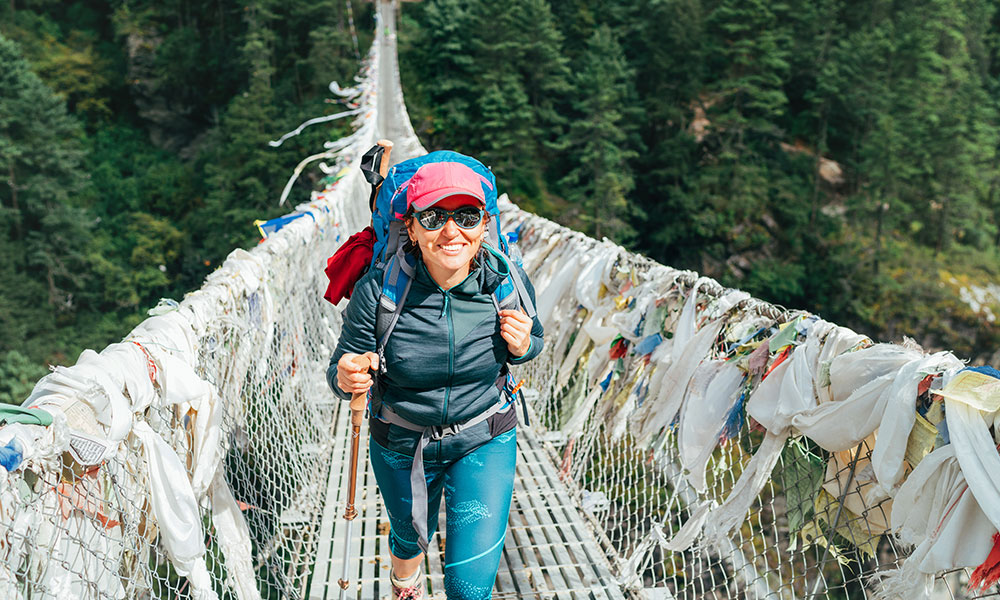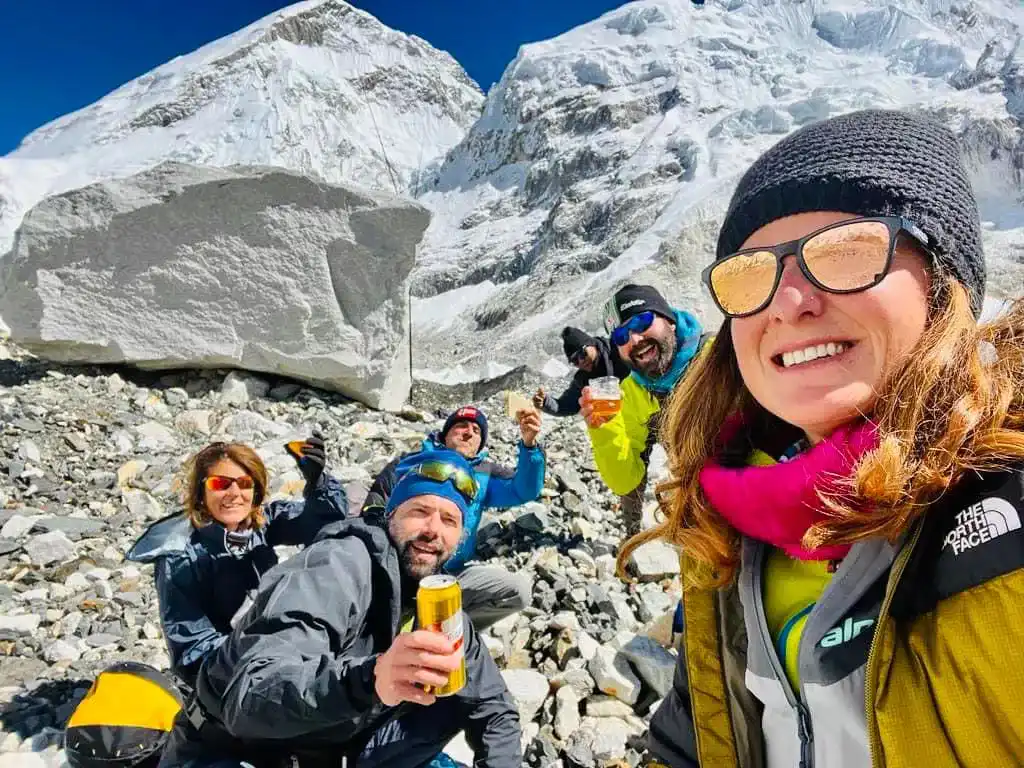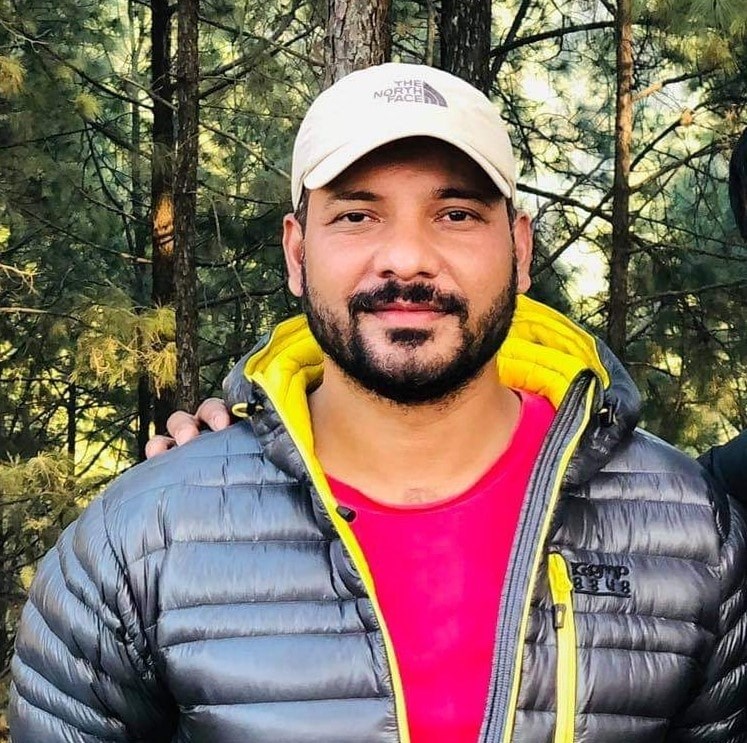There might be hardly anyone who doesn’t know about the world’s highest alpine peak, Mt. Everest, which stands at an altitude of 8,848.86 meters (29,032 feet). Like how this highest snow-clad peak on the planet is the goal of every mountaineer, the Everest Base Camp Trek which takes you to the foothill of this iconic trek, is the ultimate destination for trekking enthusiasts. Although both spring and autumn are considered to be the peak periods for this remarkable experience, the Everest Base Camp Trek in October adds a unique experience to your journey.
The month of October, which is in the core party of the autumn season (September, October, and November), has the most suitable climatic conditions as it is farther from both lingering post-monsoon rain and the pre-winter light snowfall. The temperatures in this month are just pleasant, not too hot nor too cold, perfect for outdoor walking. Similarly, due to the low precipitation rate, the days are generally clear and offer incredible views of the majestic Himalayan vistas from the trekking route. However, the foliage shades of the fall season and the harvest period, where the farmlands are covered with golden crops, add a unique perspective to this Himalayan journey.
Not to mention the incredible cultural experience that comes with immersing in some of the biggest celebrations in the country. Everest Base Camp Trek overall is a memorable and remarkable trekking adventure to admire the beauty of the mystical eastern Himalayas in a different colour. If you are looking for a pleasant trekking experience in this mainstream route in a less crowded and comfortable setting, which also adds exhilarating cultural prospects to your journey, this is the month to be in Nepal.
Everest Base Camp Trek in October- Trek Overview
Generally, your standard 12-Day Everest Base Camp Trek starts with an exciting flight over the deep valleys and lush hills from Kathmandu (1,400 meters) to Lukla (2,800 meters). However, if you have fought a fully guided trekking adventure like our 14-Days Everest Base Camp Trek, you will then spend two nights in Kathmandu before taking on the mountain trails. From Lukla, you will then walk alongside the charming banks of the Dudh Koshi River to reach your first resting destination in the trekking route, Phakding (2,652 meters). The next stop in this exciting journey is the Sherpa capital, Namche Bazaar (3,440 meters); this Shera town will also be your first-ever acclimatization destination before heading toward other high elevated points of the trekking route.
From Namche, you will continue trekking toward the high-altitude settlements of this mainstream trekking region like Tengboche (3,860 meters) and Dingboche (4,410 meters), which will be your second strategic acclimatization day before trekking further in the alpine zone. From Dingboche, you will trek along the glacial moraine and Thukla Pass to reach the Lobuche Village (4,930 meters). The next day, you will then trek past the last settlement in the EBC Trek route, Gorakshep (5,180 meters), to reach the foot basin of the highest peak on the planet, Everest Base Camp (5,364 meters). On the following day, you will then hike to the most popular viewpoint in the Everest region, Kalapatthar (5,545 meters), to enjoy the most epic views of the eastern Himalayan peaks like Everest, Nuptse, Changtse, Lhotse, and other adjacent peaks.
Your hike to the Kalapatthar will mark the end of the exploration part of your incredible Himalayan exploration. You will then retrace your step back on the mainstream Everest Base Camp Trek route from Pheriche (4,210 meters). You will then gradually trek down across Tengboche, Namche, and Phakding to reach Lukla. From Lukla, you will fly back to Kathmandu with a morning flight and will be able to enjoy the rest of the leisure day exploring the highlights of the bustling capital valley.
Table of Contents
Why Everest Base Camp Trek in October?

Pleasant Setting
Although the autumn season overall has been graded as the number one season for trekking adventures in the Nepali Himalayas, the month of October is the core period of this pleasant season. October, which avoids both pre-monsoon occasional rainfall of the early-September and the light snowfall of the late-November; thus, Everest Base Camp Trek guarantees an optimum period where every environmental factor is just right.
The weather conditions are most stable during this peak point of the autumn season; the trails are easy and dry, and the temperatures are pleasant, not too hot nor too cold, perfect for long hours of outdoor walking. The temperature of the Everest region is usually around 4°C to 17°C during October, and the night temperature can fall up to -5°C in this month.
Panoramic Mountain Views
The Everest Base Camp Trek rewards the incredible views of the magnificent eastern Himalayan peaks like Everest, Cho Oyu, Lhotse, Ama Dablam, Changtse, Makalu, and other surroundings from its trekking trail. Your Everest Base Camp Trek ensures the most pristine and clear views of these alpine peaks under a stable climate. The month of October has a lower precipitation rate compared to other months of the autumn season, and thanks to that, the skies are generally clear and less foggy.
You will be able to relish the incredible panoramic views of these popular peaks from the trekking trails as far as your eye can rich. Also, the fresh climatic conditions of the early morning and evening have a unique crispiness about them that makes the moments even more magical.
Less Crowded Trails
Even though both spring and autumn are the high season that attracts a large of trekkers and mountaineers from all around the world to the Himalayas, the crowd is pretty low during the autumn season. The lush landscapes and blooms of the spring seasons, accompanied by warmer temperatures, attract a significant number of trekkers than the foliage of the fall season. October, despite being the core period of the autumn season, receives a fairly low number of trekkers than the spring season.
Thus, if you are prepared to deal with slightly chilly climatic conditions in the alpine zones, then you can make the most out of this incredible Himalayan journey in the mainstream trekking region of the country. The less crowd on the trekking trail means you will get more time to immerse in the exploration and have a serene experience even in this mainstream route. Also, you will have enough time to have meaningful conversations with the natives and can take your time to learn more about their culture and lifestyle.
Festive Atmosphere
For those of you who didn’t know, like how October is the peak point of the autumn season, it is also the peak point for some of the most incredible celebrations in the country. Your Everest Base Camp Trek will not only ensure a memorable Himalayan trekking journey, but you will also have the opportunity to gain first-hand experience of some of the most vibrant festivals in the country.
Dahsain, the biggest festival in the country, which is celebrated for 15 days, falls in this month. Similarly, the month of October also shares the calendar with other incredible festivals in the country, like Tihar, the festival of lights, Mani Rimdu, and Pachali Bhairab. If you time it perfectly, you may get the chance to experience several festivals of the country during your Himalayan exploration in October.
Himalayan Landscapes in a Different Color
The first thing that comes to mind of travellers when they hear ‘Nepal’ is mostly the land of the Himalayas and the abundant lush greenery. However, your Everest Base Camp Trek will add a unique experience to your perspective as you traverse across the foliage of the fall seasons and the enchanting landscapes adorned with hues of grey, green, yellow, and crimson.
As nature is gradually transforming with its prominent cycle, you will be greeted by the stunning visual of the foliage color as well as the golden color of the harvest season. Walking across such amazing landscapes that reflect the different colors of the natural beauty certainly does a unique experience to make your Himalayan journey even more memorable.
Get Insights On:
- Everest Base Camp Trek Cost From Kathmandu
- Accommodation on Everest Base Camp Trek
- Everest Base Camp Elevation Guide
How Difficult is the Everest Base Camp Trek in October?
The Everest Base Camp trek is an overall moderate level of trekking experience in the eastern Himalayas. To explore this mainstream trekking route, the trekkers don’t need to have previous trekking experience or need technical skillset. This iconic Himalayan excursion can be done by anyone who doesn’t back out from putting some effort during th training part to overcome some milder hurdles of the journey. As this is a high-altitude journey, the elevation gain and long hours of walking on the rugged Himalayan trails can be demanding for unprepared trekkers.
However, one thing is sure: during Everest Base Camp Trek in October, as the weather is stable, the journey becomes more comfortable. On top of that, due to the stable weather conditions, trekkers don’t have to face weather-related challenges onthe trekking trails like the slippery routes and traversing across thick snow. Still, you should be prepared for the two major challenges of this journey like the altitude gain and long hours of trek. You will get started on the trekking trails of the classical EBC Trek from Lukla (2,800 meters), making you ascend slowly across other high-altitude points of the region; you will reach the maximum point at Kalapatthar (5,545 meters).
As there are risks to the human body to summer from Acute Mountain Sickness (AMS) over an altitude of 2,500 meters, you need to be cautious about its symptoms. The total altitude gain in this Himalayan trek is about 2,745 meters (9,005 feet), so acclimatizing properly and following precautionary methods for altitude sickness isn’t an option. Similarly, you will walk on this classical Himalayan trail for about 6 to 7 hours on average during the trekking days. Even if it is a slow-paced trek, you need to have enough stamina to make the experience enjoyable rather than just a point game to reach the next stop.
Efficient Preparation
Although the Base Camp Trek in October is a remarkable and comfortable journey, you can make the experience even more enriching with the right set of preparations. Generally, you are recommended to train at least 3 to 6 weeks before your actual trekking adventure. This way, your body will get gradually accustomed to the physical activities even if you rarely work out. If you are physically active and do workout with a schedule, then, you can adjust the training period as you see fit.
However, your foremost emphasis should be on developing your strength and stamina level. You will need to walk long hours on the rugged trails that rise slowly to higher altitudes, so extending your stamina reserve if you are not that physically active is quite essential. Similarly, taking on the steep sections, traversing across the rugged/rough Himalayan terrains, and carrying your luggage test your endurance level. So, you need to work on these factors; you can consult your trekking guide, professional trainer, or an experienced trekker to prepare an effective training program that fits your schedule.
Strength Training Exercises: Push Up, Plank, Weightlift, Pull Up, Hammer Curls, Lunges, Dips, Step Up, Leg Press, Overhead Press, Deadlift, etc
Stamina Training Exercises: Jogging, Swimming, Cycling, Dancing, Kick Boxing, Stait Climbing, Jumping Rope, Burpee, etc.
Note: You can also do practice hikes on steep terrains close to you to truly understand the physical demands of the trek and understand the physical aspects that you need to work on.
Food and Accommodation During Trek

Everest Base Camp Trek in October takes place in one of the most popular trekking regions in the entire country. Thus, unlike other isolated trekking routes of the Himalayas, you can enjoy moderate to luxurious levels of food and accommodation facilities during this Himalayan journey. On top of that, October is the harvest season of the country, which means you will be able to enjoy more extensive sets of traditional dishes during your trek.
Accommodation
In your fully guided 14 Days Everest Base Camp Trek, you will spend two of your nights in Kathmandu and 11 nights at the teahouses/lodges on the mountain. Obviously, during your stay in the bustling capital city, you will be able to enjoy a top-tier level of accommodation facilities and all the modern amenities that come along with it. You will rest at star hotels located in the core part of the capital city during your stay in Kathmandu. However, the teahouses/lodges along the mountain trails mostly offer a standard level of service.
The level of accommodation facilities will depend on what kind of package you have bought; a standard package will get your standard accommodation facilities, and a luxurious package will offer more amenities and a personalized experience. In a standard package, you will get a private room with two to three beds; although all basic amenities like pillows, blankets, and mattresses are provided, you are still recommended to bring your sleeping bag. Like the rooms, bathrooms are also mostly shared basis, and the available facilities start to slowly get limited as you ascend to higher altitudes.
Food
The food exploration prospects in this mainstream route are quite extensive; October, being the harvest season, adds even more delights to the menu. In the Everest Base Camp Trek route, you will mostly be able to enjoy the traditional Nepal dishes and Tibetan culture-influenced delicacies in almost every teahouse during your trek. Besides that, you can also enjoy the Indian culture-influenced as well as some of the popular western delights on the menu.
Menu for Breakfast at Teahouses: Tibetan Bread, Toast, Eggs Items, Muesli, Pancake, Tsampa Porridge, Chapati, Buckwheat Bread, Tingmo, Oats, Cornflakes, Tea, Coffee, Juice, Butter, Jam, Honey, etc
Menu for Lunch and Dinner at Teahouses: Traditional Daal Bhat, Dhindo, Thukpa, Shyaphale, Momo, Chowmein, Fried Rice, Aloo Tama, Yak/Chicken/Buff Steak, Pizza, Pasta, Paratha, etc.
Note: Vegetarian and vegan options are also available in the teahouses.
Permits for Everest Base Camp Trek in October

During this iconic trekking adventure in October, you will need to get two permits for the trek. You will trek across the protected national park and a restricted area of the region, so these permits are mandatory for trekking on this mainstream route.
Permits Required for the EBC Trek
- Sagarmatha National Park Entry Permit
- Pasang Lhamu Rural Municipality Permit
Sagarmatha National Park Entry Permit costs about US$ 30, and you will need it to enter the national park via Monjo. Similarly, the Pasang Lhamu Rural Municipality Permit gives you access to explore the valued restricted area of the Khumbu that has perceived the local traditional values and artifacts for decades. This permit costs about US$ 20 per trekker. You can get the national park permit at the tourism board office in Kathmandu, and as for the restricted area permit it is provided in Lukla.
Note: My Everest will take care of all the required permits for your trip and collect it on your behalf.
Packing Check-List for Your Trek in October

During your EBC Trek in October, you will follow the classical trekking route across several climatic zones, from tropical to tundra. Thus, packing the right layer is pretty important to have a comfortable experience in different climatic zones. Also, remember you will trek on the remote and isolated sections of the Himalayan region for the most part, so you should pack helpful equipment that can add value to the experience and make up for the lack of infrastructure and technological development in the region.
To make your trekking adventure light and easy-going, My Everest Trip will also provide you with strong porters who will help you with your luggage. We will provide one porter for every two trekkers, and the porter will carry about 15 kg worth of luggage of each trekker. If you want to go completely luggage-free on this exciting journey, you can hire an extra porter from us.
Packing Check-List for Head and Body
- Warm woolen or insulated hat
- Sun hat
- Scarf or cowl
- Lightweight t-shirt
- Cotton full-sleeve shirt
- Warm thermal vest
- Breathable mid-layer
- Waterproof/windproof jacket
- Minus degree down jacket
- Comfortable hiking short
- Breathable cotton pant
- Lightweight trouser
- Waterproof/windproof trousers
- Insulated or woolen trousers for alpine altitudes
- Lightweight gloves
- Windproof/waterproof or insulated gloves
- Several pairs of undergarments
Feet
- Trekking boots (break-in first)
- Lightweight socks
- Heavy insulated socks
- Flexible sports or trainer shoes
- Camping crocks or sandals
- Ankle support
- Waterproof gaiters
Toiletries/Personal Hygiene
- Bio-degradable bar soap
- Shampoo and conditioner
- Toothbrush, toothpaste
- Sunblock cream
- Lightweight travel towel
- Small mirror
- Comb, nail clipper, and shaving razor
- Tissue paper and toilet paper
- Hand sanitizer
- Body lotion
- Lip balm
- Deodorant
- Foot powder
- Insect repellent
- First aid kit
- Personal medication
Gear/Equipment
- Sunglass with UV protection
- Trekking pole
- Sleeping bag
- Duffle bag
- Packing sack
- Disposable bag
- Powerbank
- Headlamp
- Binoculars
- GPS and map
- Multi-tool knife
- Guidebook
- Magazines and journal
- Entertainment set
- Board games
- Repair tape
Cost of Trek
The standard Everest Base Camp Trek lasts around 12 to 15 days, and the general cost margin for the trekking package of this length is approximately US$ 1,400 to US$ 2,500. The cost factor will be influenced by the duration of the itinerary plans, highlighting exploration and the overall quality of the services provided. If you want to select a luxurious mode of trekking or a custom-tailored trekking package befitting your adventure plan, the cost margin for such packages can reach upto US$ 5,000.
We here at My Everest Trip offer our fully immersive 14 Days Everest Base Camp Trek at just US$ 1,395. This fully guided trekking package will handle all your itinerary plans from the date of your arrival to departure. This EBC Trek package has enough acclimatization period to make your journey comfortable, and you will also enjoy a sightseeing day around the Kathmandu Valley. For more details or any kind of inquiries, please get in touch with us via our Contact Page.
Some Helpful Tips for Base Camp Trek in October
- Enjoy a slow-paced trekking adventure; remember it is not a marathon, and you don’t need to rush as all itinerary plans are well-prepared
- You need to eat a balanced and nutritious diet and stay hydrated throughout the journey to mitigate the risks of altitude sickness and other general sickness
- Respect the local norms, traditions, and practices, and be mindful of the cultural sensitivity
- As permissions before taking photographs
- Always stick to the guidelines and suggestions of your guides and porters; they are familiar with the region like the back of their hand
- If possible, avoid alcohol and smoking throughout the trek. It’s risky to trek under the influence at high altitudes, and they also affect your acclimatization process
- Be mindful of your body language and know your limits
- In case of any discomfort and inconveniences, communicate with your trekking guide immediately
- Don’t forget to bring energy bars and snacks for a quick energy boost during your trek
- Lastly, be careful, stay safe, and enjoy the experience





